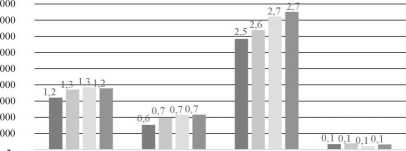2949775187
Tax expenditures: spending through the Polish tax system 99

PIT CIT VAT Excise duties
■ 2009 2010 2011 a2012 %ofGDP2009 %ofGDP2010 %ofGDP2011 %ofGDP2012
Figurę 1. Tax expenditures in State taxes in Poland (million PLN, GDP %)
Source: own study based on the reports of the Polish Ministiy of Finance.
The report distinguishes nine areas6 of tax support. In 2012, and similarly in previous years, the largest share of aid was extended in the form of family and social benefits - ca. 44.5% of all identified tax expenditures in the Polish tax system (accordingly 45.2% in 2011). In this field, tax aid amounted to ca. 36.3 billion PLN (i.e. 2.3% GDP).Most tax breaks in this group related to personal income tax (ca. 11.8 billion PLN). They principally included child tax allowances, joint assessment of spouses and social benefits exemption (Tab. 4). Most of these indirect transfers could easily be replaced with direct public programs, which should be morę targeted and income related and thus available to the less well-off taxpayers. Unfortunately, tax expenditures in Poland are not the subject of comprehensive public control assessing their effectiveness or efficiency. However, such measures would defmitely reduce the so-called “leaky bucket,, effect, resulting from non-market redistribution. They would also increase the efficiency of public spending. In the research studies there is explicitly pointed out that the child allowance introduced in 2007, as the biggest tax expenditure in the personal income tax (Tab. 3) which has improved the financial situation of many families, has not madę any significant difference to the welfare of the most disadvantaged social groups, as they are often unlikely to benefit from this kind of assistance [Horacio et al. 2009, pp. 91-114], This is because the child allowance is non-refundable, which means that it cannot bring total payable tax below zero, and as a result cannot be used to obtain a refimd. Thus it does not improve the situation of those persons whose income is so Iow that they do not have
6 1) economy, 2) agriculture, 3) employment, 4) education, science, culture, sport, 5) public benefit organizations, churches, social and civic organizations, 6) health, 7) family and social assistance, 8) transport and emironment protection, 9) others (this category includes such expenditures which cannot be attribuled to other categories).
Wyszukiwarka
Podobne podstrony:
Tax expenditures: spending through the Polish tax system 101 preferential policy of tax exemption fo
Tax expenditures: spending through the Polish tax system 103 spending and it is unfortunately gettin
Tax expenditures: spending through the Polish tax system 105 2012 30
Tax expenditures: spending through the Polish tax system 107TAXEXPENDITURES: WYDATKI POPRZEZ POLSKI
Tax expenditures: spending through the Polish tax system 93 spending taking advantage of the lack of
Tax expenditures: spending through the Polish tax system 95 comprise the nonnal tax structure and re
Tax expenditures: spending through the Polish tax system 97 Tablc 2. Size and fiscal effects of tax
Amateurish discussions of the economic functions of the Federation, the tax system, the substitution
1/ electronically through an electronic banking system used by the Bank other than the internet bank
Blejwas - American Polonia and Września The Polish Roman Catholic clergy, through the Executive Comm
March 1983ARTICLES IN POLISH Yolume 29 Number 1 J. Duszyński — Control of Flux through the Metabolic
74684 mbs 021 MY BREATHING SYSTEM Why should we Breathe through the Nose ? Naturę gave us a mouth wi
fdsg Help Tom Find His Way Through The Maże To Catch Jerry!
STUDIA I MATERIAŁY TOWARZYSTWA NAUKOWEGO NIERUCHOMOŚCI JOURNAL OF THE POLISH REAL ESTATE SCIENTIFIC
STUDIA I MATERIAŁY TOWARZYSTWA NAUKOWEGO NIERUCHOMOŚCI JOURNAL OF THE POLISH REAL ESTATE SCIENTIFIC
00154 pad31fa20becbd2e123a5d60e7c069f 155Optimization and Sensitiyity Analysis procedures. With a s
więcej podobnych podstron